Summer 2010
Volume 19 No. 2
2010 Indiana Consulting Foresters Stumpage Timber Price Report by Indiana Association of Consulting Foresters
This stumpage report is provided annually and should be used in association with the Indiana Forest Products Price Report and Trend Analysis written by Dr. William Hoover in cooperation with Indiana’s forest products companies. Dr. Hoover’s report is published in the Fall issue of the Woodland Steward. Stumpage price was obtained via a survey to all known professional consulting foresters operating in Indiana. Reported prices are for sealed bid timber sales only (not negotiated sales) between a motivated timber seller and a licensed Indiana timber buyer. The data represents approximately 10 to 15 percent of the total volume of stumpage purchased during the periods from June 16, 2009 through June 15, 2010.
The results of this stumpage price survey are not meant as a guarantee that amounts offered for your timber will reflect the range in prices reported in this survey. The results simply provide an additional source of information to gauge market conditions.
WHAT ARE SEALED BID TIMBER SALES: The sealed bid timber sale process is for trees marked by a professional forester. The species, number of trees and volume in a sealed bid sale are determined prior to the notice of sale. A notice is sent to licensed timber buyers who then inspect the timber and offer a price for said trees at a predetermined time and place. Under conditions determined in the bid notice, the owner then accepts or rejects the bids.
Upon acceptance of the bids by the owner and the fee paid, the owner then conveys the right to cut the advertised trees to the purchaser. This is frequently referred to as a lump sum timber sale. More detailed information on this process is available in Purdue FNR publication 111 – “Marketing Timber” or FNR 138 “How to get the Most from Your Timber Sale”. These publication and others are available on line at: http://www.agcom.purdue.edu/agcom/Pubs/fnr.htm. This report reflects “spot market” prices, not the average price paid by timber buyers. The bidding processed by consultants “spots” the maximum amount any buyer is willing to pay for a particular lot of timber at a particular time and place, not the average price paid for timber. High bids frequently reflect an urgent need for timber because of special orders for lumber or veneer, low log inventories at the buyer’s mill, poor logging conditions due to wet weather, or other special conditions. Hardwood lumber is sold in a highly competitive commodity market. Competition comes from mills within the state, region, and hardwood lumber producers in the Lake States, Northeast, South and Southeastern production areas. This market competition means that the cost of stumpage in other producing regions determines in part the amount Indiana mill and loggers can pay for stumpage. If all timber were sold on a bid basis the spot market would no longer exist and the average of the highest bid price offered would be lower than now observed. This explanation isn’t meant to deter you from seeking the best available price. It’s meant to explain the apparent discrepancy between the two price reporting systems.
CATEGORIES OF TIMBER REPORTED: The prices reported are broken into three sale types: high quality, average quality, and low quality. A high quality sale is one where more than 50 percent of the volume is # 2 grade or better red oak, white oak, sugar maple, black cherry, or black walnut. The low quality sale has more than 70 percent of the volume in # 3 “pallet” grade or is cottonwood, beech, elm, sycamore, hackberry, pin oak, aspen, black gum, black locust, honey locust, catalpa, or sweet gum. The average sale is a sale that is not a low quality sale or a high quality sale as defined above.
In the 2008 report, some minor adjustments were made in the categories from previous surveys. White ash was previously included as a component of the high quality timber sales and hickory was previously in the low quality group. No changes in the groups were made this year, so the 2010 data should compare well with the 2008 and 2009 data.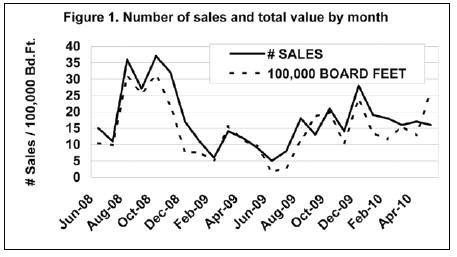
REDUCTION IN SALES CONTINUED DURING THE 2008-2010 PERIODS: In 2010, 206 sales were reported compared to 247 sales in 2009 and 283 during the same period in 2008. We had more consulting firms (21) submit data in 2010 than in 2009 (16) or 2008 (11 firms). All firms reporting in 2009 also reported in 2010 with most showing fewer sales and less overall volume than in the 2009 reporting period continuing the trend from 2008, however, activity seems to be picking up (Figure 1).
This reduction is in large part due to reluctance among most consultants to sell timber since late 2008 or early 2009 due to the economic downturn and its effect on the timber markets. A few firms did not sell any timber during this reporting period. Sales by quality type for the 2010 period were 67 (82 in 2009) high quality sales, 111 (123 in 2009) medium quality, and 28 (42 in 2009) low quality sales.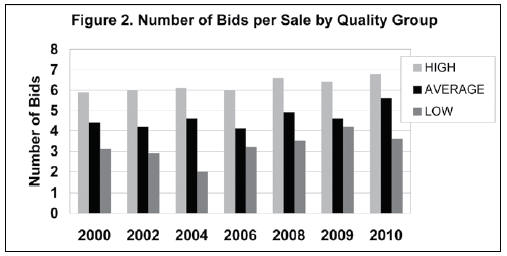
BIDDING REMAINS STRONG: In 2010 a total of 1,177 bids were received for the 206 sales or 5.7 bids per sale (Figure 2). This is the highest total recorded since the report began in 2000. The 5.7 average number of bids offered per sale included 6.8 bids for high quality, 5.6 bids for medium quality (an increase from 2009, 6.4 and 4.6, respectively) and 3.6 for low quality (a decline from 4.2 in 2009). For six sales of very high quality in 2010 (defined as sales with 5 percent or more of the estimated volume with white oak or black walnut veneer) the average number of bids was 9.2 – up from 2009 but very similar to 8.9 recorded in 2008. These figures continue to show that higher quality timber offered for sale increases buyer interest and the number of bids offered. The increase in the number of bids per sale this year may in part be due to a decreased volume of timber on the market.
REDUCTION IN VOLUME / VALUE SOLD, ESPECIALLY FOR HIGHER GRADES: A total stumpage volume of 17,687,648 board feet were sold during the 2010 reporting period compared to 19,256,439 board feet in 2009 which was down from over 25 million board feet in 2008 and 2006. High quality sales totaled 4,930,776 board feet down slightly from 2009 but down significantly from over 10 million board feet in 2008 and 2006. Medium quality sales totaled 11,299,801 board feet up slightly from 10,746,917 board feet and similar to totals from 2008 and 2006. Low quality sales totaled 1,457,071 board feet down from nearly 3 million board feet in 2009, 2008, and 2006. Some consulting firms have commented that they continued to delay some higher quality sales until recently due to the economy. Total timber value sold in the 2010 reporting period was $ 6,889,190, down slightly from $7,278,302 in 2009. Total value by type was $ 2,621,020 for high, $ 3,920,356 for medium, and $ 347,914 for low.
EFFECTS OF THE ECONOMIC DOWNTURN: Due to the drastic change in the economy in 2008, it was decided last year to collect information on the date of the timber sale in order to track month-by-month activity (Figure 1). Although the data set is relatively small, it seems to reflect market trends. Historically, late winter and early spring is typically a slower period due to wet weather and high inventories at the sawmills. The levels in the summer and fall of 2008, prior to the downturn were consistent with previous years.
Beginning in December 2008 and generally continuing through July 2009 the number of sales and timber marketed dropped considerably. Since then activity has increased, although at a gradual level. Activity did drop in late winter as it typically does, even though sawmill inventories were low. Indications for the last few months show an increase level of activity and most consultants have indicated they plan to sell more timber this year.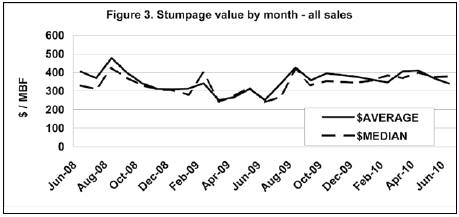
Stumpage Value ($/MBF) has dropped from the fall of 2008 until the summer of 2009, showing a spike in August of 2009 then receding slightly then trending mostly upward (Figure 3). The median price appears to be a better indicator due to less influence of higher quality sales that can distort the average price. Comments by several consultants indicate they believe current prices are similar to 2007 levels, which the data supports. (See Figures 4 and 5.)
STUMPAGE PRICE INCREASING FROM 2009: The average stumpage price for 2010 for high quality was $532 – down from $572 in 2009 (median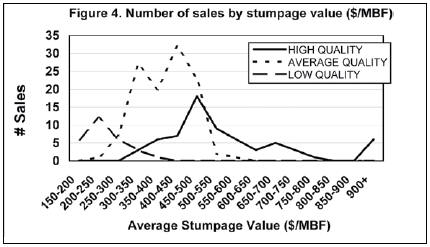 price $498 vs. $549 in 2009) (Figure 4). Although this level is down, last year’s values for high quality only dropped 3 % for the year. The largest influence may be due to the reluctance of consultants to sell quality timber, especially sales with much black cherry, which has seen steep drops in prices.
price $498 vs. $549 in 2009) (Figure 4). Although this level is down, last year’s values for high quality only dropped 3 % for the year. The largest influence may be due to the reluctance of consultants to sell quality timber, especially sales with much black cherry, which has seen steep drops in prices.
The percentage of high quality sales has dropped from an average of approximately 40% of sales sold in 2004 thru 2008 to 28 % for 2009 and 2010. All indications are that black walnut and larger diameter white oak are doing extremely well. The average stumpage price for average quality was $347 in 2010 – up from $320 in 2009 (median price $352 vs. $314 in 2009). The median price for average quality was similar to the median stumpage price in 2008 ($359) and 2006 ($357). The number of sales and volume of average quality timber sold has remained fairly constant at 11 to 12 million board feet per year since 2006.
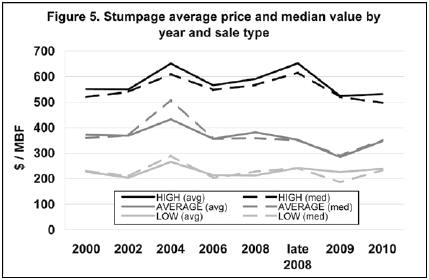
The average stumpage price for low quality was $239 in 2010 – up from $225 in 2009 (median price $234 vs. $228 in 2009). The price for low quality has trended up for several years. The weighted average and median stumpage price by sale type (obtained from this survey in 2000, 2002, 2004, 2006, 2008, 2009, and 2010) is reported in Figure 5.
The weighted average of the stumpage price is the total value ($) for each sales group (high, average, low) divided by the total volume by sales group. The median price is the amount where half of the sales are higher and half are lower. The price reported is per 1000 board feet (MBF) of standing timber. To obtain a price per board foot, divide the price by 1000. An average price of $378 per thousand MBF is the same as 37.8 cents per board foot stumpage. This compares to an average stumpage price for high quality sale was $532/MBF, $347/ MBF for average quality, and $239/ MBF for low quality. Below is a statistical summary for all three sale types.
SUMMARY: The last 18 months to 24 months have been very volatile. Fortunately, things are looking up. Prices mostly are back to 2007 levels so more timber is going on the market. Concerns over an increase in capital gains tax (anticipating increasing from 15 % to 20 % in 2011) may also influence the supply of timber for the rest of 2010.
When the economic downturn began many sawmills had large inventories of standing timber, logs, and lumber. Those inventories have been reduced resulting in an increase in demand for standing timber. Although demand is less than a few years ago the current supply of timber on the market appears to be less than the current supply. The industry seems to be carrying a smaller inventory and cutting sales quicker than in the past, creating more of a spot market for timber sold. The values for some species such as cherry are still low so there still is some reluctance by some consultants to sell timber from some woods.
The comment section below is offered to our readers by the consulting foresters who participated in this survey:
• Cautiously optimistic about the timber markets and the economy therefore planning to put more timber on the market in 2010.
• Current mill inventories and inventories of standing timber are very low resulting in more demand for standing timber. Current supply on the market appears to be less than current demand resulting in higher prices at this time at least for standing timber.
• Timber industry is still struggling with stumpage prices increasing and lumber prices remaining low.
• Wet weather this spring has reduced delivered logs and has reduced sawmill inventories.
• Black walnut moving extremely well with larger diameter white oak also in high demand.
• Black cherry market still soft, so I am not marking healthy, good quality cherry. Sugar maple and red oak improving.
• Now is a good time for landowners to apply for timber stand improvement (TSI) cost share money as funds are readily available thru the local USDA offices.

Consulting Foresters that have contributed to this report in alphabetically order include: Arbor Terra Consulting (Mike Warner) Jim Akard, Crowe Forest Management LLC (Tom Crowe), Doll Forestry Consulting, LLC (Steve Doll), ABC Forest Management (Brian Cruser), Christopher Egolf, Forest Management Services, Inc. (Larry Owen), Gandy Timber Management (Brian Gandy), Gregg Forestry Services (Mike Gregg), Haney Forestry, LLC (Stuart Haney), Haubry Forestry Consulting, Inc.
(Rob Haubry), Multi-Resource Management, Inc. (Fred Hadley, Thom Kinney, Justin Herbaugh), Meisberger Woodland Management (Dan Meisberger), North Slope Forestry (Don Duncan), Stambaugh Forestry (John Stambaugh), Steele Forestry Consulting (Rhett Steele), Tree Inc. (Tim Martin), Turner Forestry, Inc. (Stewart Turner), and Forestry Options (Barry Wilson), Wakeland Forestry Consultants, Inc. (Bruce Wakeland).
